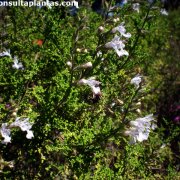Care of the shrub Salvia namaensis or Nama sage |
|
The genus Salvia, family Lamiaceae, comprises 1,000 species of shrubs and herbaceous plants native to Asia, Africa, the Mediterranean region, and Central and South America. Some species are: Salvia namaensis, Salvia microphylla, Salvia mexicana, Salvia mellifera, Salvia leucantha, Salvia lanceolata, Salvia guaranitica, Salvia greggii, Salvia farinacea, Salvia disermas, Salvia canariensis, Salvia aurea, Salvia apiana, Salvia africana, Salvia scabra, Salvia splendens, Salvia vaseyi, Salvia leucophylla, Salvia verbenacea, Salvia sclarea, Salvia nemorosa, Salvia officinalis, Salvia fruticosa, Salvia elegans, Salvia x sylvestris. Common name: Nama sage. This species is native to Namibia and South Africa. They are fast-growing and highly branched evergreen semi-woody shrubs that reach 1 meter (3.28 feet) in height. The leaves are aromatic, lobed and lime green in color. The flowers appear in whorls and are white or light blue. They bloom in spring and summer. Nama sage is used in rockery, on sunny slopes, in dry areas of the garden in groups and in pots. It combines well with plants of the Aloe, Osteospermum, Erica and Protea genera. Salvia namaensis prefers full sun exposure and warm climates such as the Mediterranean or subtropical. It does not resist cold below 5 ºC (41 ºF). Nama sage can be grown in sandy and rocky soils but prefers well-drained soil rich in organic matter. Planting is done in late spring. Salvia namaensis is a plant resistant to drought; It appreciates regular watering in summer, always waiting for the soil to completely dry out. Fertilize with compost and mineral fertilizer in spring to improve flowering. Prune heavily every 2-3 years because they tend to grow out of order. Salvia namaensis is a plant resistant to pests and diseases but sensitive to excess humidity. Nama sage is propagated from seeds sown in early summer or late spring; germinate quickly. It can also reproduce by cuttings but it's a slower process. |
Images of the shrub Salvia namaensis or Nama sage |
Find plants
Salvia namaensis or Nama sage | Care and Growing
© 2025 FavThemes


